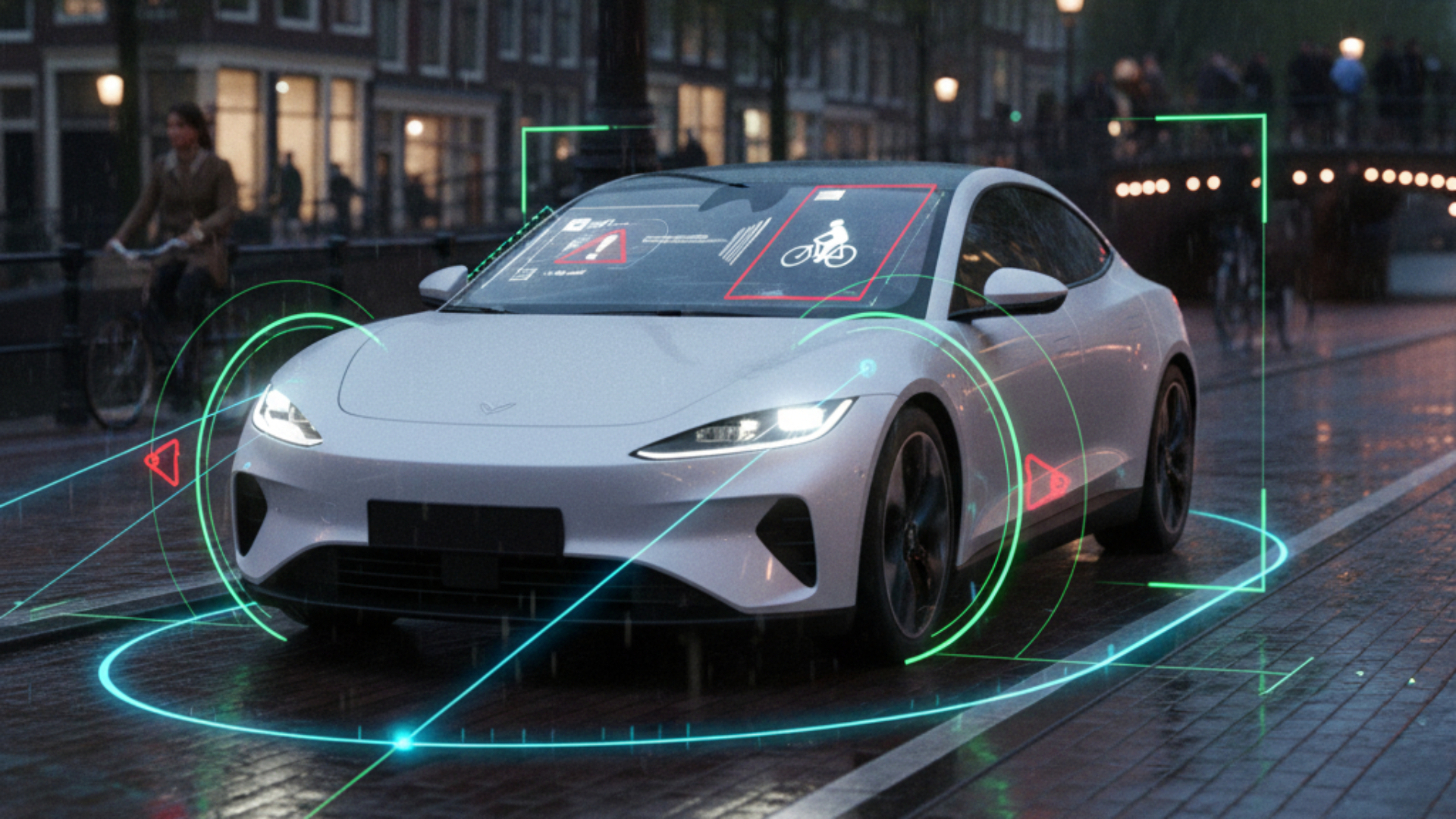These mean the ADAS abbreviations – Advanced Driver Assistance Systems
The first forms of driving assistance emerged in the 1970s, with systems such as ABS (Anti-lock Braking System). Since then, car manufacturers have made huge strides. Modern cars are equipped with all kinds of sensors, radar, lidar and cameras that constantly monitor the car’s surroundings. These are linked to systems that warn the driver and/or intervene if necessary, temporarily steer the car within safe limits and bring the car to a stop on the side of the road if the driver is unwell. These are the advanced driver assistance systems, ADAS.
Origin of ADAS
The development of ADAS is inextricably linked to technological advances in the automotive industry. When it came to safety, the emphasis used to be on passive safety – occupant protection in the event of an accident, such as larger bumpers, crumple zones and, later, airbags. So by then, the accident had already occurred. Those safety measures are still important, but in recent decades the focus has been on active safety: preventing accidents rather than mitigating their effects on the occupants.
Alphabetical overview of the most important ADAS
We give an overview of the most important current ADAS systems and describe them in understandable language. We start from the most common abbreviations because they are usually mentioned and their meaning is not always clear. Car manufacturers sometimes use slightly different abbreviations or give their own marketing name to certain (combinations of) systems. Consider Tesla’s Autopilot or Ford BlueCruise.
ACC – Adaptive Cruise Control: the name says it all: an advanced version of cruise control. ACC not only keeps the speed constant, but also the distance to the car in front by adding gas or braking if necessary (see also CC – Cruise Control).
ABS – Anti-lock Braking System: the anti-lock braking system keeps the wheels from locking when the driver brakes forcefully. This allows him to keep the car under control even during emergency braking.
ADDW – Advanced Driver Distraction Warning: this system notices when the driver is distracted, such as when he looks at his phone or at people on the sidewalk instead of paying attention to the road. ADDW alerts the driver when he is not paying attention.
AEB – Autonomous Emergency Braking: autonomous emergency braking system that detects an imminent accident and then automatically performs emergency braking. If the driver also brakes himself, AEB increases braking pressure to shorten the stopping distance or reduce the impact of a collision.
AES – Autonomous Emergency Steering: automatically/autonomously adjusts if it detects an imminent collision that cannot be avoided by braking alone. AES avoids obstacles if possible.
AH – Adaptive Headlights: adaptive headlights automatically adjust their direction and brightness to the situation. When cornering, they turn in the direction steered, and in the case of oncoming traffic they dim partially to prevent glare.
AP – Assisted Parking: parking assistance assists the driver in congestion parking by steering automatically. The driver only has to operate the accelerator and brake pedals (see also RCP – Remote Control Parking).
BSW – Blind Spot Warning: blind spot warning. If a fellow road user is in the blind spot of your car, BSW warns you with a light up in the exterior mirror on that side of your car.
CC – Cruise Control: the regular cruise control that maintains the set speed so that the driver does not have to accelerate (see also ACC – Adaptive Cruise Control).
CTA – Cross Traffic Alert: warning system for intersecting traffic, for example in unclear situations such as leaving a parking space or between buildings.
CSW – Curve Speed Warning: warns the driver if the car is about to take a curve at too high a speed.
DCAS – Driver Control Assistance System: collective name for advanced systems that assist the driver with braking, acceleration and steering, combined with DMS (see DMS – Driver Monitoring System). The car can drive partially autonomously and also continuously monitors via cameras whether the driver is alert. DCAS forms the basis for autonomous driving in the future.
DDAW – Driver Drowsiness and Attention Warning: fatigue and alertness warning system analyzes steering movements, driving behavior and driver alertness to detect fatigue. Issues warnings if necessary and recommends a break.
DMS – Driver Monitoring System: keeps a close eye on the driver via a camera and checks that he is paying attention to the road.
ELKS – Emergency Lane Keeping System: assistance system that automatically adjusts if the driver threatens to unintentionally leave his lane.
ESP – Electronic Stability Program: stability control system regulates power to prevent wheels from slipping and the car from becoming unbalanced. If necessary, ESP brakes individual wheels and reduces engine power.
ESS – Emergency Stop Signal. When braking suddenly, the brake lights flash rapidly to warn following traffic.
FCW – Forward Collision Warning: warning system for an imminent collision with an obstacle in front of the car.
HDA – Highway Driving Assist: highway assist combines adaptive cruise control and lane assist to support the driver on long highway trips (see also ACC – Adaptive Cruise Control and LKA – Lane Keep Assist).

ISA – Intelligent Speed Assistance: intelligent speed assistant reads traffic signs and helps the driver keep to the speed limit. Depending on the version, the system informs, warns and/or limits the speed.
LC – Lane Centering: actively keeps the car in the center of the lane, often in conjunction with Lane Keep Assist (see also LKA – Lane Keep Assist).
LDW – Lane Departure Warning: warns the driver if the car is in danger of leaving the lane (unintentionally) without the driver using the turn signal (see also LKA – Lane Keep Assist).
LKA – Lane Keep Assist: lane keep assist steers lightly or gives a warning if the car is in danger of leaving the lane.
OA – Overtaking Assistance: assists overtaking with ACC by temporarily increasing the speed and then adjusting it again (see also ACC – Adaptive Cruise Control).
PCB – Post-Collision Braking: automatically brings the car to a stop after a collision to reduce subsequent damage.
PCW – Pedestrian and Cyclist Collision Warning: detects vulnerable road users (the pedestrians and cyclists in the system’s name) in the car’s direction of travel and warns the driver. PCW is often integrated with AEB (see AEB – Autonomous Emergency Braking).
RAB/RAEB – Rear Automatic (Emergency) Braking: brakes automatically when the system detects obstacles or people behind the car while reversing.
RCP- Remote Control Parking: the driver can park and exit the car without being in it.

RCTA – Rear Cross Traffic Alert: warning system for crossing traffic á behind the car, for example in unclear situations such as leaving a parking space in reverse or between buildings (see also CTA – Cross Traffic Alert).
RCW – Rear Collision Warning: warning system for an imminent collision with an obstacle á behind the car.
RV – Rearview Camera: rearview camera. Displays situation behind the car via screen in the dashboard.
RED – Road Edge Detection: alerts the driver if the car gets too close to the edge of the road and adjusts if necessary.
SCF – Speed Control Function: limits the maximum speed set by the driver (see also ISA – Intelligent Speed Assistance).
SLIF – Speed Limit Information Function: reads traffic signs and displays the applicable speed limit on the dashboard (see also ISA Intelligent Speed Assistance).
SV – Surround Vision: ambient camera gives a 360o view of the situation around the car. Useful when parking and maneuvering.
TJA – Traffic Jam Assist: traffic jam assistant. Supports the driver in slow-moving traffic with automatic steering, braking and acceleration.
TPMS – Tire Pressure Monitoring System: tire pressure monitoring system. Warns of pressure loss.
TSR – Traffic Sign Recognition: recognizes traffic signs and displays them on the screen in the car.
VRU – Vulnerable Road User Detection: identifies vulnerable road users (cyclists and pedestrians) in the area and intervenes to prevent a collision (see also PCW – Pedestrian and Cyclist Collision Warning.
Which ADAS systems are mandatory in new cars?
ABS (Anti-lock Braking System) has been mandatory in new cars in the Netherlands since 2004. ESP – Electronic Stability Program followed at the end of 2014. Since July 7, 2024, the following systems are mandatory in new cars: AEB – Autonomous Emergency Braking, DDAW – Driver Drowsiness and Attention Warning, ELKS – Emergency Lane Keeping System, ISA (Intelligent Speed Assistance) and RV – Rearview Camera.
Starting July 7, 2026, ADDW – Advanced Driver Distraction Warning will be added. But never forget: despite all driving assistance and safety systems, the driver remains responsible for the safe operation of his car at all times.
ADAS: the future of safe driving
Technology is developing faster and faster: from the simple cruise control to systems that actively assist the driver and take over actions. Thanks to the application of ADAS, traffic is becoming safer.
ADAS Alliance
The Dutch ADAS Alliance has defined all the key terms and functions for consumers. It is a Dutch alliance of more than 60 public and private organizations – governments, industry associations such as RAI Vereniging, insurers, knowledge institutions and car manufacturers. The alliance is committed to the proper use of ADAS and focuses on ADAS users. It publishes (information) products such as the ADAS Dictionary, which describes the most common driving assistance systems by category.

